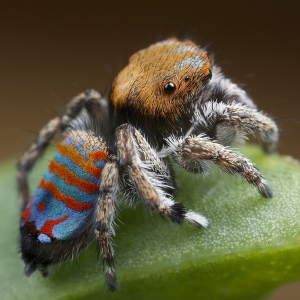
Peacock spiders are very small arachnids found in Eastern Australia. These creepy crawlies are as small as a pencil eraser. The male peacock spider is well known for its bright colors and showy mating dance, so it is bound to attract any Arachnologist.
Maddie Girard, a Ph.D student at the University of California, and her friend Eddie King traveled to Australia to study the mating dance and actions of the peacock spider, when they came across two new peacock spider species. Skeletorus, or
maratus sceletus
, was named for the white marks on the dark-as-night body and legs.
Maratus jacatus
, who is also called “Sparklemuffin,” was given its nickname by Girard. Sparklemuffin's very vibrant midsection is a flashy red and blue and is a true sight to see.
“These spiders are spectacular. Its a mind blowing find,” said arachnologist Damian Elias also from the University of California.
Experts also suggest that the peacock spider is a cousin to the common jumping spider, which is found almost everywhere. Jumping spiders don't spin webs but instead prefer hunting prey themselves. According to Elias,“their eyesight is incredible, they can see as [well] as cats.” So far, all 53 of the known
maratus
spiders are found only in Eastern Australia, but there is a certain photographer, Jurgaen Otto, who has already found 20 new species. He believes there is a vast number of undiscovered
maratus
spiders left in the world. Otto indicated,“the diversity of these spiders is enormous and new ones keep coming up.”
Otto found one new peacock spider during a visit to the Sydney Musuem, which he later named
maratus elephans
for its elephant like pattern on its flaps protecting its back. One of Otto's friends brought him two living male
maratus elephans
and one female. In his house, on a table he photographed the mating dance of the peacock spider. First, the male raises his back legs a few inches away from the female and begins waving them around. Then, he opens his flaps and waves them around with the beat. Next, the female slowly closes in, and the male begins to shiver and roll into a tight ball, creating wave after wave of vibrations that act like Morse code to the female.
Male peacock spiders are the easiest to tell apart, but almost all females are identical. According to Otto, a male will preform for any female of any species, which is very risky for the male because he becomes easy prey while dancing.
The peacock spider was first found during the 1800's but, was not studied until the late 1950's, possibly due to their small size. Because of the low number of professional scientists researching peacock spiders, more aspiring scientists or other explorers are finding the new species. These unique arachnids are not the biggest, or most powerful, but they certainly are smart, quick, and adaptive.
[Source:
National Geographic
]

